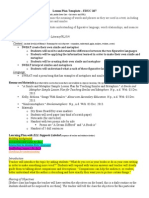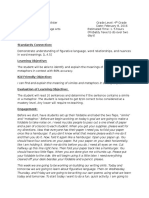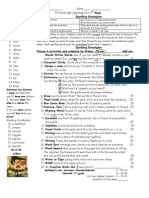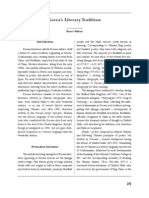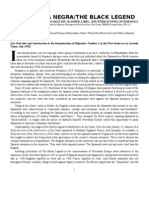L
Uploaded by
api-528986192L
Uploaded by
api-528986192UNLV/Department of Teaching & Learning
Elementary Lesson Plan Template
UNLV Student: Lauren Logan PSMT Name: Dr. Holmes
Lesson Plan Title: Metaphors and Lesson Plan Topic: Metaphors and
Similes Similes
Date: 10/22/20 Estimated Time: 20 min
Grade Level: 4th School Site: Jones Blackhurst
Elementary
________________________________________________________
1. State Standard(s):
L.4.5a Explain the meaning of simple similes and metaphors (e.g. pretty as a picture) in context
2. Teaching Model(s): Direct Instruction
Whole Group Instruction
Virtual Instruction
3. Objective(s): SWBAT correctly identify the two things being compared in a metaphor
SWBAT interpret a metaphor
SWBAT discuss the similarities and differences between similes and
metaphors using a double bubble map
4. Materials and Technology Resources:
Metaphors Google Slide
Double Bubble Map
5. Instructional Procedures:
a. Motivation/Engagement (3-4 minutes):
o Students will be asked where they most commonly see figurative language
being used through a google pool. The options are Poetry, Prose, or Drama
(The three types of literature we have been discussing in our Reading lessons.)
o Students will answer the pool and teacher will review the answers with them.
While we can see figurative language in prose or dramas, we most frequently
see it used in Poetry.
o Students will review why authors use figurative language and how it can help
them become better writers.
o Finally, Students will review what a Simile is. (a comparison using like or as)
b. Developmental Activities or Learning Experiences (20 Minutes):
o Students will be presented with the definition of a metaphor. Metaphors are a
comparison in which the author says one thing is another. This is a stronger
comparison and more implicit. Students will discuss the meaning of implicit
versus explicit.
o Students will then be presented with three different metaphors and be asked
to identify the two things that are being compared.
o Students will then complete a double bubble map comparing similes and
metaphors. Teacher will prompt as needed. The three similarities should be:
both are a comparison, both are examples of figurative language, both are
used by authors to make their writing more colorful and interesting. The
features unique to similes are that they use the words “like” or “as”, they are
a more explicit comparison, they are a weaker comparison. The features of
metaphors are they compare two things by saying that one thing is or was
another, they are a more implicit comparison, and they are a stronger
comparison.
o Lemov Strategies: Wait time, Begin with the End, On Your Mark
c. Closure (5): Students will review the double bubble map and how we can use this
knowledge in our own writing
d. Extension/Contingency(+/- 5 minutes):
Extension: Have students write their own metaphors about a haunted house and
have the class identify what two things are being compared and interpret the
metaphor
Contingency: Have students complete the double bubble map in groups after
completing one bubble in each category as a class.
6. Accommodations, Modifications and Differentiations for Diverse Learners:
a. Accommodations: Students are able to use the google feature “speech to text” to type
their answers.
b. Modification: Teacher will make the PowerPoint available for all students to review
in their own time.
c. Differentiation: Students are provided both verbal and visual aids in their lesson, and
are instructed through lecture and video.
7. Assessment and Evaluation of Learning:
a. Formative: Students will complete a metaphor practice assessment which requires them
to identify if a sentence is a simile or metaphor, what two things are being compared,
interpret a provided metaphor, and create their own metaphoe
b. Summative: Students will complete a summative assessment once they have completed
the entire standard.
8. Homework Assignment: No Homework given in language
9. Reflection:
a. Strengths: This lesson went well and included a lot of different ways to deliver the instruction,
which I think my students enjoyed.
b. Concerns: The pacing in this lesson was a bit slow, and I would have liked to get to the
extension activity.
c. Insights: This lesson helped me see how important it is to keep the lesson moving swiftly. It is
difficult virtually due to the time it takes a student to unmute and give an answer.
You might also like
- Eddn 680 - Siop 2nd Observation Lesson 1No ratings yetEddn 680 - Siop 2nd Observation Lesson 118 pages
- Analyzing Figures of Speech to Get and Clarify Meaning SimileNo ratings yetAnalyzing Figures of Speech to Get and Clarify Meaning Simile5 pages
- Knack Jill Martin Cameron Revisedlesson Lai574 1No ratings yetKnack Jill Martin Cameron Revisedlesson Lai574 14 pages
- 6963 Angelina Salerno Unit 5 Mastery 99970 1594358875No ratings yet6963 Angelina Salerno Unit 5 Mastery 99970 15943588754 pages
- DAILY LESSON PLAN.docx(jan.27,2025)docs.No ratings yetDAILY LESSON PLAN.docx(jan.27,2025)docs.6 pages
- Lesson Plan Created For A University Prep Listening and Speaking CourseNo ratings yetLesson Plan Created For A University Prep Listening and Speaking Course2 pages
- A Simile and Metaphor Sample Lesson Plan For TeachingNo ratings yetA Simile and Metaphor Sample Lesson Plan For Teaching2 pages
- Daily Lesson Log: Lian Institute 7 Ms. Maria Vanette O. Japay SecondNo ratings yetDaily Lesson Log: Lian Institute 7 Ms. Maria Vanette O. Japay Second3 pages
- Metroplex Center Lesson Plan Template For Formal ObservationsNo ratings yetMetroplex Center Lesson Plan Template For Formal Observations4 pages
- Lesson Plan Template: NEPF + Components of An Effective Lesson HybridNo ratings yetLesson Plan Template: NEPF + Components of An Effective Lesson Hybrid4 pages
- Finals ENGL 224 (Deped LP) - Amparo Andrey MarieNo ratings yetFinals ENGL 224 (Deped LP) - Amparo Andrey Marie5 pages
- Motivational Lesson Plan Edu 615 Elizabeth GilleyNo ratings yetMotivational Lesson Plan Edu 615 Elizabeth Gilley5 pages
- 5400 Lesson Plan 1 Revised Portfolio DraftNo ratings yet5400 Lesson Plan 1 Revised Portfolio Draft15 pages
- The Links and Differences Between Advertising, Propaganda and Promotion, EssayNo ratings yetThe Links and Differences Between Advertising, Propaganda and Promotion, Essay8 pages
- English To Bisaya Translation - Google Search PDFNo ratings yetEnglish To Bisaya Translation - Google Search PDF1 page
- 7 Major Basic Principles of Islamic Administration1150% (6)7 Major Basic Principles of Islamic Administration1145 pages
- The Concepts of Indian Dramatic TraditioNo ratings yetThe Concepts of Indian Dramatic Traditio8 pages
- Book Review of A Social History of The DeccanNo ratings yetBook Review of A Social History of The Deccan6 pages
- Gender Related To Success in Science and Technology: Linda Rae MarkertNo ratings yetGender Related To Success in Science and Technology: Linda Rae Markert9 pages
- Integrity: Academic and Political A Letter To My StudentsNo ratings yetIntegrity: Academic and Political A Letter To My Students6 pages
- Analisis Tokoh Dan Penokohan Pada Drama RT Nol RW Nol Karya Iwan SimatupangNo ratings yetAnalisis Tokoh Dan Penokohan Pada Drama RT Nol RW Nol Karya Iwan Simatupang10 pages
- THBT Parents Should Be Responsible For Their ChildrenNo ratings yetTHBT Parents Should Be Responsible For Their Children3 pages
- India by Design: Colonial History and Cultural Display, by Saloni MathurNo ratings yetIndia by Design: Colonial History and Cultural Display, by Saloni Mathur5 pages








